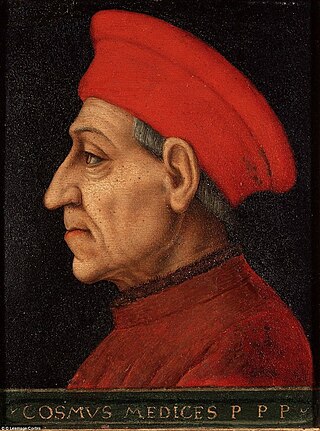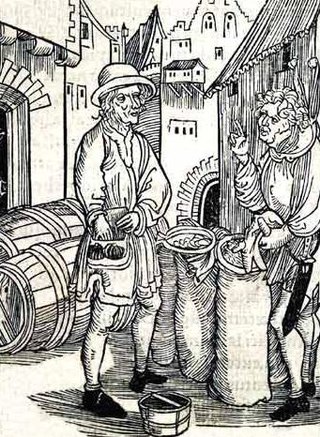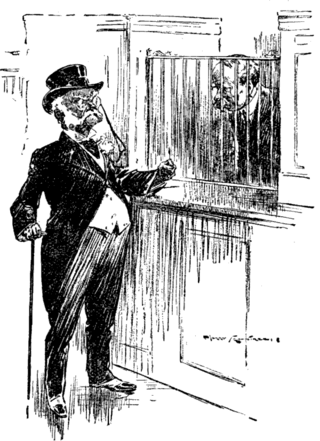Related Research Articles

In finance and economics, interest is payment from a borrower or deposit-taking financial institution to a lender or depositor of an amount above repayment of the principal sum, at a particular rate. It is distinct from a fee which the borrower may pay to the lender or some third party. It is also distinct from dividend which is paid by a company to its shareholders (owners) from its profit or reserve, but not at a particular rate decided beforehand, rather on a pro rata basis as a share in the reward gained by risk taking entrepreneurs when the revenue earned exceeds the total costs.

Cosimo di Giovanni de' Medici was an Italian banker and politician who established the Medici family as effective rulers of Florence during much of the Italian Renaissance. His power derived from his wealth as a banker, and inter-marriage with other powerful and rich families. He was a patron of arts, learning, and architecture. He spent over 600,000 gold florins on art and culture, including Donatello's David, the first freestanding nude male sculpture since antiquity.

Usury is the practice of making unethical or immoral loans that unfairly enrich the lender. The term may be used in a moral sense—condemning taking advantage of others' misfortunes—or in a legal sense, where an interest rate is charged in excess of the maximum rate that is allowed by law. A loan may be considered usurious because of excessive or abusive interest rates or other factors defined by the laws of a state. Someone who practices usury can be called a usurer, but in modern colloquial English may be called a loan shark.

Fractional-reserve banking is the system of banking in all countries worldwide, under which banks that take deposits from the public keep only part of their deposit liabilities in liquid assets as a reserve, typically lending the remainder to borrowers. Bank reserves are held as cash in the bank or as balances in the bank's account at the central bank. Fractional-reserve banking differs from the hypothetical alternative model, full-reserve banking, in which banks would keep all depositor funds on hand as reserves.

The Peruzzi family were bankers of Florence, among the leading families of the city in the 14th century, before the rise to prominence of the Medici. Their modest antecedents stretched back to the mid 11th century, according to the family's genealogist Luigi Passerini, but a restructuring of the Peruzzi company in 1300, with an infusion of outside capital, marked the start of a quarter-century of prosperity that brought the family consortium to the forefront of Florentine affairs.

The history of banking began with the first prototype banks, that is, the merchants of the world, who gave grain loans to farmers and traders who carried goods between cities. This was around 2000 BC in Assyria, India and Sumer. Later, in ancient Greece and during the Roman Empire, lenders based in temples gave loans, while accepting deposits and performing the change of money. Archaeology from this period in ancient China and India also shows evidence of money lending.
A contractum trinius was a set of contracts devised by European bankers and merchants in the Middle Ages as a method of circumventing canonical laws prohibiting usury as a part of Christian finance. At the time, most Christian nations heavily incorporated scripture into their laws, and as such it was illegal for any person to charge interest on a loan of money.

A mount of piety is an institutional pawnbroker run as a charity in Europe from Renaissance times until today. Similar institutions were established in the colonies of Catholic countries; the Mexican Nacional Monte de Piedad is still in operation.

An overdraft occurs when something is withdrawn in excess of what is in a current account. For financial systems, this can be funds in a bank account. In these situations the account is said to be "overdrawn". In the economic system, if there is a prior agreement with the account provider for an overdraft, and the amount overdrawn is within the authorized overdraft limit, then interest is normally charged at the agreed rate. If the negative balance exceeds the agreed terms, then additional fees may be charged and higher interest rates may apply.

Pawnbroking, lending money on portable security, began in ancient history. The practice was widespread in many parts of the world, from ancient Greece to medieval China and medieval Europe.

A money changer is a person or organization whose business is the exchange of coins or currency of one country for that of another. This trade was a predecessor of modern banking.

The Medici Bank was a financial institution created by the Medici family in Italy during the 15th century (1397–1494). It was the largest and most respected bank in Europe during its prime. There are some estimates that the Medici family was, for a period of time, the wealthiest family in Europe. Estimating their wealth in today's money is difficult and imprecise, considering that they owned art, land, and gold. With this monetary wealth, the family acquired political power initially in Florence, and later in the wider spheres of Italy and Europe.

Tommaso Portinari was an Italian banker for the Medici bank in Bruges. He was a member of a prominent Florentine family, coming from Portico di Romagna, near Forlì; that family had included Dante's muse, Beatrice Portinari. His father was a Medici branch manager, and after his death in 1421, Tommaso and his orphaned brothers were taken in and raised in the household of Cosimo de Medici. Today he is mainly remembered for two significant commissions of Early Netherlandish paintings.

Francesco Sassetti was an Italian banker.
Vix pervenit is an encyclical, promulgated by Pope Benedict XIV on November 1, 1745, which condemned the practice of charging interest on loans as usury. Because the encyclical was addressed to the bishops of Italy, it is generally not considered ex cathedra. The Holy Office applied the encyclical to the whole of the Roman Catholic Church on July 29, 1836, during the reign of Pope Gregory XVI.

A credit card is a payment card, usually issued by a bank, allowing its users to purchase goods or services or withdraw cash on credit. Using the card thus accrues debt that has to be repaid later. Credit cards are one of the most widely used forms of payment across the world.

The Avignon Exchange was one of the first foreign exchange markets in history, established in the Comtat Venaissin during the Avignon Papacy. The Exchange was composed of the agents (factores) of the great Italian banking-houses, who acted as money-changers as well as financial intermediaries between the Apostolic Camera and its debtors and creditors. The most prosperous quarter of the city of Avignon, where the bankers settled, became known simply as the Exchange. According to de Roover, "Avignon can be considered an Italian colony, since the papal bankers were all Italians".

A bank is a financial institution that accepts deposits from the public and creates a demand deposit while simultaneously making loans. Lending activities can be directly performed by the bank or indirectly through capital markets.
Raymond Adrien Marie de Roover (1904–1972) was an economic historian of medieval Europe, whose scholarship explained why Scholastic economic thought is best understood as a precursor of, and wholly compatible with, classical economic thought. In contrast, many mid-20th-century economic historians, such as R.H. Tawney, taught that Karl Marx was the last and greatest of the Scholastic economists.
Inflationary bias is the outcome of discretionary monetary policy that leads to a higher than optimal level of inflation. Depending on the way expectations are formed in the private sector of the economy, there may or may not be a transitory income increase. The term may also refer to the practice of a public debt-ridden nation enacting policies which encourage inflation in the medium/long term.
References
- Notes
- ↑ pg 54 of De Roover 1948
- Bibliography
- Medici money: banking, metaphysics, and art in fifteenth-century Florence , Tim Parks. 2005, W. W. Norton & Company, Inc., ISBN 0-393-05827-1 (2005 hardcover 1st printing)
- De Roover (1904-1972), Raymond Adrien (1948), The Medici Bank: its organization, management, and decline, New York; London: New York University Press; Oxford University Press (respectively)
{{citation}}: CS1 maint: numeric names: authors list (link) (Largely a reprint of three articles De Roover published in The Journal of Economic History .)